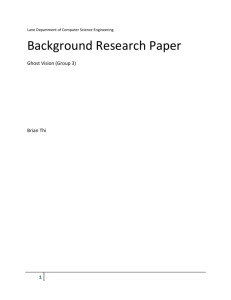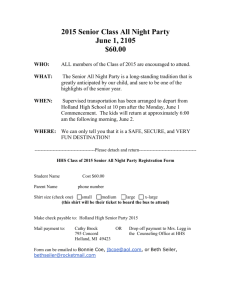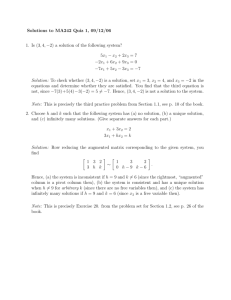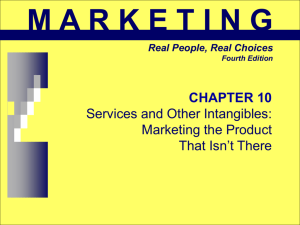HHMI Faculty Research Grant Program Name of PI: Michael Jipping
advertisement
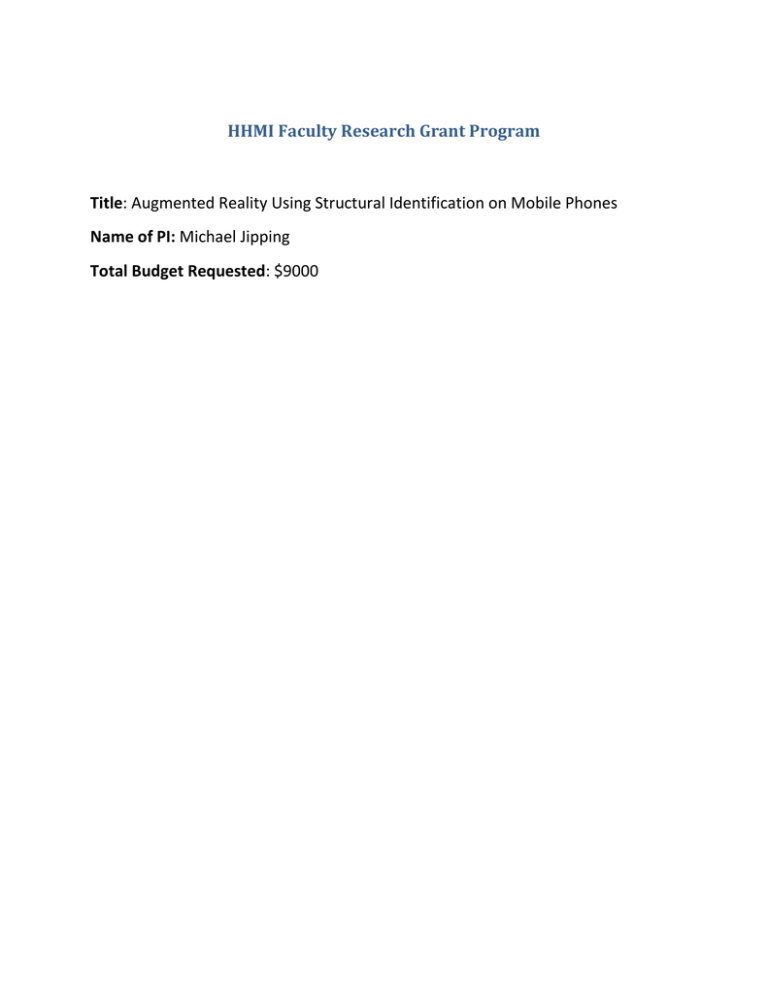
HHMI Faculty Research Grant Program Title: Augmented Reality Using Structural Identification on Mobile Phones Name of PI: Michael Jipping Total Budget Requested: $9000 Augmented Reality Using Structural Identification on Mobile Phones Michael Jipping Computer Science Department Project Abstract Augmented reality (AR) is the process of adding or accessing information on top of realtime physical scenes. Sports coverage is a simple example of AR; football coverage is often broadcast with colored lines and measurements superimposed on the field. AR is often dependent on proprietary systems using larger computers, but efforts are currently underway to bring AR to mobile devices. This project will accomplish this and build a framework so such a system can be used openly by everyone to combine various types of information with AR algorithms. The project specified here is one that (1) investigates methods to identify physical surroundings in realtime and (2) builds this capability into a system that allows information to be added to the realtime analysis. The key to this project is that the result of this research will be an open source system that will support the creation of augmented reality system that will run on a smartphone platform. There are two expected outcomes from this project. First, we will develop a software system and programming interface that will recognize physical surroundings, specifically buildings and architectural structures, in realtime on a smartphone using builtin sensors and realtime video. Second, we will begin to build a framework for adding information to this physical object recognition. This framework will most likely take the form of a system of Web pages through which information can be assembled, then made accessible to the AR system on the mobile device. 1 Proposal Narrative Consider two actual scenarios involving augmented reality. • • A class at Hope College is studying the history of Holland. As a way to experience this history, the class builds a collection of historical facts, pictures, and documents about the buildings that surround Centennial Park. This type of class project brings the history of Holland into focus, looking at the narrative and documentation of a specific area. As a way to make this information more accessible, the class wants to build this information into an interactive application on a smartphone. This application will analyze video taken as a person walks around Centennial Park, showing each building and allowing the person to read the facts, see the pictures, and access the documents that are in the class collection. The City of Holland is starting a pilot project where 90 municipal and residential buildings in the Holland area will be retrofitted to dramatically increase their energy efficiency. They are seeking ways to merge the collection of data they have on the older energy usage with new data they will be collecting on the buildings involved in the pilot project. The City wants this comparison of data to be accessible to the people living in and using the buildings in the project as well as others who might be interested in increasing their own energy efficiency. They want to use smartphone-based AR to display and compare data for the buildings included in the pilot project as well as other municipal building for which they have been collecting data for a long time. Both of these scenarios are real1. Both require the realtime identification of physical surroundings overlaid on a smartphone screen with information about those surroundings. This interactive combination of realtime video and data, called augmented reality (AR), is possible on a smartphone but has, up until now, only been done using large computers with proprietary systems. This proposal requests funding for a project that (1) investigates methods to identify physical surroundings in realtime and (2) builds this capability into a system that allows information to be added to the realtime analysis. The project specified here will focus on building ways to use AR on Android mobile phone devices. Efforts are currently underway to bring AR to mobile devices. This project will join this effort and build a framework so such a system can be used openly by everyone to add various types of information to the AR algorithms. There are two expected outcomes from this project. First, we will develop a software system and programming interface that will recognize physical surroundings, specifically buildings and architectural structures, in realtime. Second, we will begin to build a framework for adding information to this physical object recognition. This framework will most likely take the form of 1 The first scenario has been suggested by faculty in Hope’s English department and is an example of digital humanities, a way of intersecting computation with humanities disciplines (a great collection of definitions can be found at [1]; the definition of digital humanties is well developed at [2]). Bill Pannapaker could partner in the project. The second scenario has been suggested by people connected with the City of Holland’s “City Energy Plan.” Three task forces on building energy retrofits and building labeling are considering various options for rating and labeling building energy efficiency and want all this data accessible via smartphone. 2 a system of Web pages through which information can be assembled, then made accessible to the AR system on the mobile device. Introduction and Background Augmented reality has a history of speculation and dreams. In 1901, the author L. Frank Baum describes the idea of a “character marker,” an electronic device that overlays data onto real life seen through spectacles [4]. Ivan Sutherland, known as a pioneer in computer graphics, invented a head-mounted display in 1966 that displayed computer data over the real world. The current studies into AR started in the mid-1990’s, where several projects built prototype systems that displayed realtime, data-enhanced video to computer users. The common element in these early systems was the large size of the computers that were required to house the computing power needed to process the large amounts of realtime video data. Handheld computing started improving system performance at the turn of the millennium. In 2000, the video game Quake was used to develop an outdoor mobile AR version. In 2008, an augmented reality version of a travel guide was introduced onto the first Android mobile phone. Today, there are several different types of devices using many different applications of AR. Devices from mobile smartphones to headmounted displays (see Google Glasses [5]) are used. Each of these applications involve specific targeted data on proprietary or closed AR platforms. Open frameworks that allow easy application of AR technology by people who are not computer scientists do not exist at the present time. This proposal focuses on software to determine structural identification. Structural identification can be implemented in two ways. The first approach, called “marker-based” technology, involves multidimensional markers that can be recognized using computer video and image analysis. This could be as simple as using QR codes on building doors that can be scanned with an application that uses a barcode reader to identify them. The second approach is based on geolocation and device orientation. For this second approach, an application can deduce the position on the earth where it is (for example, by using a global positioning system (GPS)) and the direction and position in three dimensions (for example, by using an electronic compass and an accelerometer). By crossing this positional data with map data and video feed, it is possible to identify landmarks. Augmented reality systems would use structural identification and combine it with databases of information. Such a system would allow a user to specify what information would be connected with various structures and where on the display information would appear. Project Details and Objectives During the summer of 2013, we will be developing an AR system with two objectives. 1. Develop a structure recognition system. This is the research component. Here, we want to use a geolocation-based method with edge- and shape-recognition algorithms. The result will be a software system that will analyze the various sensors on a 3 smartphone to identify structures. In particular, we will develop software for an Android mobile smartphone that will use the sensors available on the device to identify structures. This software will connect structures with identifying information, perhaps with a name or an address. 2. Begin to work with users to develop an information gathering system for the AR. This begins the augmented reality component. This system will take the structural recognition system and will build an AR system from it. It will involve a user interface – perhaps through Web pages – that will allow users to design where information is located once a structure is identified. In particular, this part of the project will develop a Web-based system for the specification of where information comes from and where it will be displayed on the screen of an Android device. We will then begin to combine the two parts together into the final AR system. The project has great potential. It is certainly a feasible project, as shown by current applications (e.g., [3]). But there are difficulties that must be surmounted. Working with students who are not familiar with Android development will take some time and the realtime aspect of identification is daunting. Working with open source data (such as that provided by Google Maps) and the wealth of sensor data on a smartphone should allow help solve with this challenge. Based on the work already done in this area, we should be able to complete step 1 this summer. We expect to start step 2, working with the collaborators we have specified (the English department and the City of Holland), in the fall. Project Significance and Impact This project takes work that Dr. Jipping has done over the past two years and pushes it in a new direction. Dr. Jipping has done previous work with optical algorithms and this project will focus that experience on structural objects and by using the software experience on Android to build this research into a software application for those mobile smartphones. The project also gives Dr. Jipping an instant audience for this type of development: both the English department and the City of Holland would take advantage of the software coming from this project. The research contributions of this work add to its value. Systems are already starting to emerge (e.g., Nokia’s City Lens [3]). However, these systems are (a) not open sourced and (b) not available for regular users to populate with their own data. The system proposed here would contribute to opening AR up to all users. This work will produce software that is not already available. An open source, easily configurable system like this would be a great contribution to the AR area. This work has the potential to contribute to the use of devices that are under development but not yet publicly available. A great example is the Google Project Glass [5], which is working to 4 produce a mass-produced, wearable computer system that is designed to use AR. When this device is publicly available, having an existing, open AR system would allow that system to be ported quickly. Google Glass will likely be partnered with an Android-based smartphone, so work done on this project will be directly applicable. The development of open source identification algorithms is new, original work that can be published in and presented at conferences. The software itself will be disseminated through the Internet in app stores (e.g., the Android Market) and in forums. In addition, students can get into the act by helping with tutorials, Web site design, and documentation development. And the application of this work to the real needs of Hope College and the City of Holland will also determine its impact. Finally, the impact on students will be immediate and powerful. Students supported by the NSF REU grant will work alongside the researcher on this project. They will learn about optical algorithms, geolocation data, realtime sampling of sensor information on mobile devices, and the advantages and pitfalls of open-source software. They will also get a taste of working with “clients” that do not speak the language of computer science. 5 References [1] Association for Computers and the Humanities, home Web page available online at http://www.ach.org [2] Association for Computers and the Humanities, “Digital Humanities Questions & Answers,” available online at http://digitalhumanities.org/answers/topic/what-is-digital-humanities [3] Bonetti, P, “Nokia City Lens 1.5 beta for WP7”, available online at http://conversations.nokia.com/2012/11/28/nokia-city-lens-1-5-beta-for-wp7/ [4] Johnson, Joel. “The Master Key: L. Frank Baum envisions augmented reality glasses in 1901” Mote & Beam, September 10, 2012. [5] Wikipedia, “Project Glass”, available online at http://en.wikipedia.org/wiki/Project_Glass. 6 Project Budget This project’s budget request is for support for Dr. Jipping and to provide for mobile phone equipment for use in the project. • Funds for Jipping: 10 weeks at $800 per week, for a total of $8000. The 10 week duration is requested to fit with the NSF REU program, which is actually 9 weeks. • Funds for equipment: two mobile phones are requested that will serve as the platform on which to build/demonstrate the system. Each phone is approximately $500. • Hope will cover all other costs. Two or three students will be provided from the NSF REU funding the department receives. Other costs include computing facilities with which to build the software, servers to house the AR system, and space in which to work. The project will be included in the department’s summer research program activities. Total budget request = $9000. 7 Biographical Sketch Michael J. Jipping PROFESSIONAL PREPARATION Ph.D. in Computer Science, 1986, The University of Iowa, Iowa City, Iowa 52242. M.S. in Computer Science, 1984, The University of Iowa, Iowa City, Iowa 52242. B.S. in Computer Science, 1981, Calvin College, Grand Rapids, Michigan 49506. APPOINTMENTS Professor, Department of Computer Science, Hope College,Holland, Michigan 49423 (2003 - present). Department Chair, 2003 - present. Associate Professor, Department of Computer Science, Hope College,Holland, Michigan 49423 (1994 - 2003). Assistant Professor, Department of Computer Science, Hope College,Holland, Michigan 49423 (1987 - 1994). Research Fellow, NASA Langley Research Center, Information Systems Division, System Architecture Branch, Hampton, VA 23681 (June - August, 1992). Assistant Professor, Department of Computer Science, The University of Iowa, Iowa City, Iowa 52242 (August, 1986 - August, 1987). PUBLICATIONS: Most Closely Related B. Galiceanu, H. Willee, M. Barros de Almeida, M. Jipping, P. Nathani, Python on Symbian, CreateSpace Publisher, November 2010. Also available online at http://www.developer.nokia.com/Community/Wiki/Python_on_Symbian M.J. Jipping, Smartphone Operating System Concepts with Symbian OS, published through Symbian Press by J. Wiley and Sons, February, 2008. M.J. Jipping, Communications Programming for Symbian Devices, published through Symbian Press by J. Wiley and Sons, July, 2002. M.J. Jipping, G. Lewandowski, “Parallel Processing over Mobile Ad Hoc Networks of Handheld Machines”, extended abstract, 2001 Mobile Ad-Hoc Computing Conference, Monterrey, California, October 2001. M.J.Jipping, S.Dieter*, J.Krikke*, S.Sandro*, “Using Handheld Computers in the Classroom: Laboratories and Collaboration on Handheld Machines”, Proceedings of the 2001 SIGCSE Technical Symposium, SIGCSE Technical Bulletin, Vol. 33, No. 1 (March 2001), pp. 169173. PUBLICATIONS: Other Significant M.J. Jipping, C. Calka*, B. O’Neill*, and C. Padilla*, “Teaching Student Java Bytecode Using Lego Mindstorms Robots,” Proceedings of 2007 SIGCSE Technical Symposium, March, 2007. SIGCSE Technical Bulletin, Vol 39, No. 1 (March 2007). 8 M.J. Jipping, S. Henry*, K. Ludewig*, L. Tableman*, “How to Integrate FPGAs into a Computer Organization Course”, Proceedings of the 2006 SIGCSE Technical Symposium, SIGCSE Technical Bulletin, Vol. 38, No. 1, (March 2006), pp. 234-238. M.J. Jipping, A. Kalafut*, N. Kooistra*, K.Ludewig*, "Investigating Wired and Wireless Networks Using a Java-based Programmable Sniffer", Proceedings of the 2004 ITiCSE Technical Symposium, June, 2004, pp. 12-16. M.J. Jipping, K. Bruce, "Imperative Language Paradigm", chapter 90 in The Computer Science Engineering Handbook, Second Edition, A. Tucker, Ed., CHapman/Hall CRC, 2004, pp. 90-1 - 90-22. M.J. Jipping, A. Bugaj*, L. Mihalkova*, and D. Porter*, “Using Java to Teach Networking Using a Programmable Network Sniffer”, Proceedings of the 2003 SIGCSE Technical Symposium, SIGCSE Technical Bulletin, Vol. 35, No. 1 (March 2003). SYNERGISTIC ACTIVITIES • Chair of Computer Science department at Hope College • Participant in Liberal Arts Computer Science (LACS) consortium • Reviewer for NSF CCLI, CAREER, and REU proposals • Reviewer for SIGCSE, iTiSCE, and IEEE Computer COLLABORATORS AND OTHER AFFILIATIONS Herbert L. Dershem, David Berque, Alyce Brady, David Reed, Henry Walker, Charles Kelemen, Max Hailpern, Rhys Price-Jones, Kim Bruce, Gary Lewandowski 9 Current and Pending Support Title: REU SITE: An Undergraduate Research Program in Biomedical Applications in Computer Science Funding Source: National Science Foundation, grant 0851293 Amount: $320,686 Time Commitment: none (giving up PI to someone else) Title: Augmented Reality Using Structural Identification on Mobile Phones Funding Source: Hope College Faculty Development Grant Amount: $3600 Time Commitment: same as this proposal Note: If this proposal is funded, the Hope grant is to be returned. Title: Supporting Digital Humanities with Augmented Reality and Structural Identification on Mobile Phones Funding Source: pending at GLCA NDI Program Amount: $5300 Time Commitment: 8 weeks during summer Note: If both proposals are funded, HHMI could complement the GLCA funds. 10

